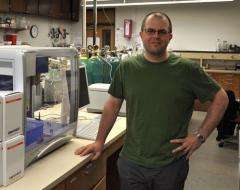Dormant microbes promote diversity, serve environment: study

(PhysOrg.com) -- The ability of microbes, tiny organisms that do big jobs in our environment, to go dormant not only can save them from death and possible extinction but may also play a key role in promoting biodiversity and ecosystem stability.
In a paper published this week in the Proceedings of National Academy of Sciences, Michigan State University’s Jay Lennon and Stuart Jones described how they used a mathematical model and molecular tools to study how dormancy affects the biodiversity of natural microbial communities, especially in lakes.
Dormancy is a reversible state of low metabolic activity that an organism enters when it encounters stressful conditions, such as starvation or cold temperatures. The strategy is common among plants and animals, but is also used by some microbes, most notably bacteria that cause anthrax, tuberculosis and cholera. This new study shows that dormancy is not just important for disease-causing microbes, however.
“Microbes are the most abundant and diverse organisms on earth; they carry out essential ecosystem services” said Lennon, an assistant professor of microbiology and molecular genetics who is also affiliated with the W.K. Kellogg Biological Station. “Among these services are contaminant degradation, carbon sequestration and various processes that affect plant productivity.”
Scientists have recently cataloged thousands of microbial species in soil and ocean samples. These extremely high levels of biodiversity may help ensure the stability of ecosystem processes in the face of environmental change. It is not clear, however, why microbial communities are so diverse. “We think,” Lennon said. “that dormancy is a critical factor that maintains microbial diversity.”
Gathering samples from Michigan lakes, Lennon and Stuart examined two very different groups of microbes - bacteria and eukaryotes, which are primarily algae. With the molecular data and models they developed, the researchers found that microbial seed banks - seeds that have been dormant in the lakes - are important, but, in Lennon’s words, “not all microbes are the same.”
“Bacteria appear to rely on dormancy more so than eukaryotic microbes,” he said. “When faced with unfavorable conditions bacteria may simply go to sleep. There are risks to this strategy - but it pays off if a microbe wakes up before dying and conditions are favorable once it is resuscitated. Essentially, a dormant organism is able to escape the bad times.”
On the other hand, the vast majority of algae and related species were metabolically active. “In lakes, dormancy was less important for eukaryotic microbes.” Because they are larger than bacteria, algae sink faster and may not wake up before it is too late. These differences in dormancy may be important for predicting how populations respond to disturbance and environmental change.
One important discovery was that environmental conditions or “cues” seem to determine the microbes’ degree of dormancy. Lennon said they found that dormancy was less common in high productivity lakes. Lake productivity tends to be controlled by nitrogen and phosphorus concentrations, which can be linked to climate change and land use activity.
Dormancy in microbes has been studied for more than a century, Lennon said, especially as it relates to disease. For example, tuberculosis can lay dormant in a human for years before becoming reactivated. Dormancy also appears to be important for microbes in the environment, and may help us understand what regulates the tremendous amount of microbial diversity that is found in virtually all natural ecosystems.
Provided by Michigan State University














